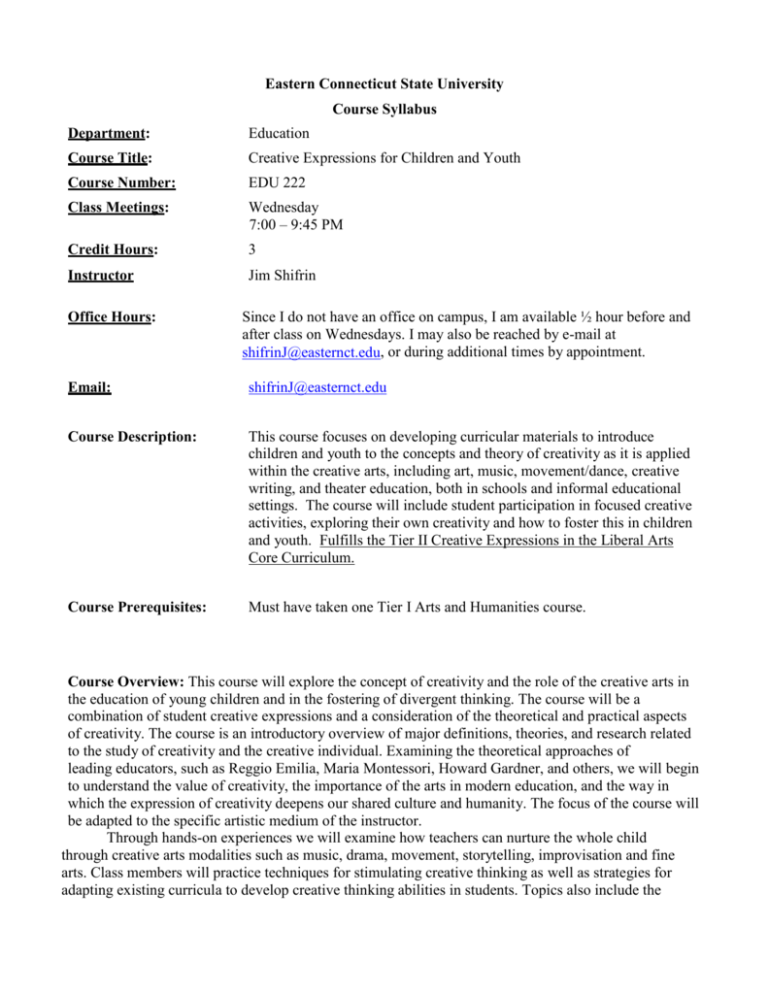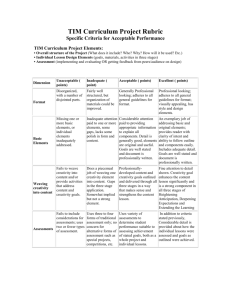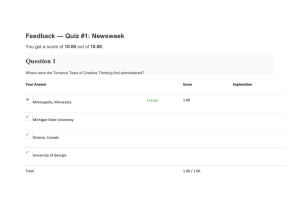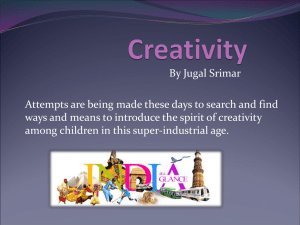EDU 222: Creative Expressions for Children and Youth
advertisement

Eastern Connecticut State University Course Syllabus Department: Education Course Title: Creative Expressions for Children and Youth Course Number: EDU 222 Class Meetings: Wednesday 7:00 – 9:45 PM Credit Hours: 3 Instructor Jim Shifrin Office Hours: Since I do not have an office on campus, I am available ½ hour before and after class on Wednesdays. I may also be reached by e-mail at shifrinJ@easternct.edu, or during additional times by appointment. Email: shifrinJ@easternct.edu Course Description: This course focuses on developing curricular materials to introduce children and youth to the concepts and theory of creativity as it is applied within the creative arts, including art, music, movement/dance, creative writing, and theater education, both in schools and informal educational settings. The course will include student participation in focused creative activities, exploring their own creativity and how to foster this in children and youth. Fulfills the Tier II Creative Expressions in the Liberal Arts Core Curriculum. Course Prerequisites: Must have taken one Tier I Arts and Humanities course. Course Overview: This course will explore the concept of creativity and the role of the creative arts in the education of young children and in the fostering of divergent thinking. The course will be a combination of student creative expressions and a consideration of the theoretical and practical aspects of creativity. The course is an introductory overview of major definitions, theories, and research related to the study of creativity and the creative individual. Examining the theoretical approaches of leading educators, such as Reggio Emilia, Maria Montessori, Howard Gardner, and others, we will begin to understand the value of creativity, the importance of the arts in modern education, and the way in which the expression of creativity deepens our shared culture and humanity. The focus of the course will be adapted to the specific artistic medium of the instructor. Through hands-on experiences we will examine how teachers can nurture the whole child through creative arts modalities such as music, drama, movement, storytelling, improvisation and fine arts. Class members will practice techniques for stimulating creative thinking as well as strategies for adapting existing curricula to develop creative thinking abilities in students. Topics also include the assessment of creative thinking, methods for enhancing personal creative abilities, and techniques for examining the creative process. We will begin this course by exploring our own creativity and our own arts education. We will ask, what is creativity and how do we develop it in ourselves and students? We will examine the role that the arts have played in our lives as well as the role that gender, socioeconomic class, race and ethnicity influence our experiences with and access to creativity and the arts. After inward reflection, we will begin to think broadly about creativity and the arts as it pertains to young children and permeates our schools. We will then design, participate in and analyze various creative activities from a variety of creative arts modalities, including music, movement, drama and the fine arts. We will collaborate to create a tangible resource book which will be filled with practical activities and lesson ideas. We will engage in the arts community on campus, as well as explore places that foster creativity for children within the community. Readings used in this course: Althouse, R., Johnson, M. & Mitchell, S. ( 2003). The colors of learning: Integrating the visual arts into the early childhood curriculum. New York: Teachers College Press/ Washington, DC: NAEYC. Edwards, Betty. (1999). The new drawing on the right side of the brain: A course in enhancing creativity and artistic confidence. New York: Tarcher. Englebright Fox, J. & Schirrmacher, R. (2012). Art & creative development for young children. (7th Ed.) Belmont, CA: Wadsworth. Gardner, H. (1993). Creating Minds: An anatomy of creativity as seen through the lives of Freud, Einstein, Picasso, Stravinsky, Eliot, Graham, and Gandhi. New York: Basic Books. Gardner, H. (2006). Multiple intelligences: New horizons in theory and practice. New York: Basic Books. Isbell, R. & Raines, S. (2013). Creativity and the arts with young children. Australia: Wadsworth Cengage Learning. Peterson, L. & O’Connor, D. (2006). Kids take the stage: Helping young people discover the creative outlet of theater. New York: Back Stage Books. Starko, A. (2005). Creativity in the classroom: Schools of curious delight. New York: Routledge. Zakkai, Jennifer. (1997 ). Dance as a way of knowing. York, ME: Stenhouse Publishers. Kaufman, J. & Sternberg, R., eds. (2010). The Cambridge handbook of creativity. Cambridge, NY: Cambridge University Press. Course Objectives: All course goals, objectives, and themes are interconnected with the Education Unit Conceptual Framework Candidate Proficiencies (ECP), Connecticut Pre-service Teacher Competencies (PTC), 2010 Connecticut Common Core of Teaching (CCT), the Common Core State Standards. The following table shows the elements of ECP, PTC, and CCT. Eastern Candidate Proficiencies (ECP) Content Knowledge (CNK) Pedagogical Knowledge (PDK) Integration of Knowledge (INT) Technology as a Tool to Teach (TTT) Diversity (DIV) Professionalism (PRF) Preservice Teacher Competencies (PTC) 1: Development and Characteristics of Learners 2: Evidence-based/Standards-based Instruction 3: Evidence-based Classroom and Behavior Management 4: Assessment 5: Professional Behaviors and Responsibilities Common Core of Teaching (CCT) Domain 1: Content and Essential Skills Domain 2: Classroom Environment, Student Engagement, and Commitment to Learning Domain 3: Planning for Active Learning Domain 4: Instruction for Active Learning Domain 5: Assessment for Learning Domain 6: Professional Responsibilities and Teacher Leadership The table below provides an outline of how the goals and objectives of this course align with the ECP, PTC, and the ACEI standards. Also, each goal/objective is associated with a student product that would be completed during the course. Course Goals/Objectives ECP, PTC, and CCT Alignment Products By the end of the course students will: 1) Students will explore and increase their personal creative abilities (visual arts, dance, music, theatre), exploring their attitudes towards creativity and creative expression through hands-on participation in a variety of creative modalities. 2) Students will describe the major theories and models of creativity (visual arts, dance, music, theatre) that attempt to describe creative people, creative processes, and creative products. 3) Students will analyze the concept of creativity (visual arts, dance, music, theatre) and the role that it plays in education. ECP: 1, 3 CCT: 1 ACEI: 2.5, 2.7, 3.1 Tier II Creative Expressions: 2 Participation Creative Assignments In-class experiences ECP: 1 and 2 PTC: 1 CCT: 1 ACEI: 2.5, 2.7, 3.1, 5.5, 5.2 Participation Creative Assignments Book Review ECP: 1, 2 PTC: 1, 2 CCT: 1, 4 ACEI: 2.5, 2.7, 3.1, 4.0 Tier II Creative Expressions: 3 Weekly Reflections Participation Lesson Plan Course Goals/Objectives ECP, PTC, and CCT ECP: 2, 3 PTC: 2, 4 CCT: 2, 3, 4, 5 1, 4 ACEI: 2.5, 2.7, 3.13.5, 4.0 ECP: 1, 2, 3 Students will investigate different theoretical approaches to education PTC: 2, 4 and use those approaches as a lens CCT: 3, 4 ACEI: 2.5, 2.7, 3.1, for exploring the communication 4.0 of ideas through the arts. Tier II Creative Expressions: 2 ECP: 2, 5 Students will describe factors that PTC: 1, 2, 4 influence the development, CCT: 2, ACEI: 2.5, assessment, and evaluation of 2.7, 3.1, creative potential in individuals. Tier II Creative Expressions: 2 ECP:2, 5 Students gain an in-depth PTC: 1, 2, 4 understanding that creativity is a CCT: 2, 3, 4, 5 developmental process that is ACEI: 2.5, 2.7, 3.1, unique to each child. 3.2, 4.0 ECP: 1,3 Students will analyze processdriven art versus product-driven art PTC: 1 and discuss the potential value that CCT: 1 ACEI: 2.5, 3.1, 4.0 each can have. Alignment Products 4) Students will discuss classroom activities, practices, and organizational strategies that support the development of creativity. Participation Weekly Reflections Lesson Plan 5) Participation Analysis of Institution Book Review 6) 7) 8) 9) Students will analyze programs and curricular materials designed for the development of creative thinking abilities. ECP: 2, 4, 5 PTC: 2, 4, 5 CCT: 3, 4, 5 ACEI: 2.5, 2.7, 3.1, 3.3 4.0 Tier II Creative Expressions: 2 Weekly Reflections Analysis of Institution Weekly Reflections Participation Weekly Reflections Analysis of Institution In-class experiences Analysis of Institution In-class assignments Attendance and Class Participation 20 % Regular attendance and active participation is mandatory in this course. Weekly Reading Reflections and exit comments 10% You will write weekly reflections on topics of your own choosing although they must be based on the readings (those assigned and/or your chosen book). You may also include responses referring to your field experiences, or any observations, questions, and/or ideas you have related to course content. These papers should be maintained in a folder for easy review at the end of the semester. These reflections will be about ¾ - 1 page each. These need not be polished, but writings that allow you to reflect and respond. You will write 10 entries in all. On the days that these are due (as indicated on the schedule) you will bring them to class. At the end of our class period you will be given 5 minutes to add additional comments related to that class period. This is an opportunity to make comments, ask questions, and give feedback to the instructor. Be sure to hand-in before you leave in order to get credit. 10 entries (1 page each) Personal Enrichment Experiences 20% You will participate in (or attend) at least two arts-based events on campus or in the community. After each, you will write a paper that includes a description of the event (name, date, time, place) and explains your experience and what you got out of it. The paper should demonstrate connections to course ideas. 2 write-ups (1-2 pages each) Analysis of an Institution 15% You will visit and write an analysis of the educational offerings of a local art museum, children’s museum, or school (either an event or classroom observation) in order to assess the opportunities for creative expression and aesthetic appreciation that exist in the State of Connecticut. 3 pages Book - Reading and Review 15% There is no assigned text for this course. It will be your responsibility to choose a book related to Creativity (but not necessarily the arts) to read during the semester. It is your choice whether to read it all at the beginning or throughout the semester, but you may not wait to begin until the end. Your reading reflections will be based at least in part on this reading. You will become an ‘expert’ on your chosen topic for purposes of class discussions. Toward the end of the semester, you will write a review of your book, summarizing main points and describing what you learned as well as analyzing concepts as they relate to course ideas. 3 pages Final Presentation The main purpose of this project is to give you the opportunity to synthesize what we have read and discussed about the value of creativity in the classroom. You will have an opportunity to select a modality (with prior consent from the instructor) through which you will express your learning. This assignment will also allow you to hear the experiences and perspectives of your classmates. The final exhibition of creative products will happen during our final class meeting. You may present alone, or with a partner. Personal Reflection 20% You will review your reading reflections and consider your own values and personal experiences, both in and out of this course. You will create a paper that describes your current understandings and beliefs about the value of creativity in general (and the arts in particular) and its role in teaching and learning. 5 pages EDU 222 Week: 8/28 9/4 9/11 9/18 9/25 10/2 10/9 10/16 Course Outline: Introductions /Review Syllabus What is Creativity? Theories and Models of Creativity Multiple Intelligences and Differentiated Curriculum 11/6 11/13 11/20 Bring chosen book to class Understanding Visual Arts and Aesthetics * Creating Art * Understanding Music * Making Music * Understanding Creative Movement and Dance * Moving and Dancing * Write-up on creative experience #1 * 10/23 10/30 Assignments Due: Understanding the Dramatic Arts Acting and Improvising The Environment – Creating a Creative Space Integrating the Arts 11/27 Teaching Strategies to Support Creative Development 12/4 Student Presentations *Weekly reading reflections * Analysis Of Institution * * Book Review Write-up on Creative Experience #2 OR Lesson Plan Final Product Reflection Paper due 12/4 Course Topics may include: The importance of creativity in human development, with particular emphasis on visual arts and music. The developmental progression at different ages; changing focus at different levels; from process-oriented to representational and symbolic. Focus on practice: Integration of recommended practices regarding visual arts and music into daily activities. Development of a repertoire of activities. Demonstration of a variety of ways in which creativity may be intentionally integrated into curricular plans and other professional growth opportunities. Integration of art appreciation throughout the curriculum. Visual teaching and learning strategies. Art and music as experiments and experiences to further develop one’s creativity. Curricular webbing and team-work to identify a broad range of potential art and music activities to expand and enhance the creative process. Selection of materials to support the creative process. Identification of a range of materials, including “found” or re-cycled as well as manufactured or home-made. Organizing materials for easy access. Selection of musical instruments. Design of environments to support artistic activities. Consideration of environmental factors such as organization, safety, acoustics, and amount of stimulation. Adjustment of curriculum to meet the unique needs of everyone. Consideration of individual characteristics in each person and how development can be supported through artistic and musical activities. Support of expression through the arts; using the arts as a form of communication. Assignment of Grades: Students will be assigned grades based on the quality of their work on all assignments. Grades will be calculated using the following weighting: Project: Percentage of Final Grade: Attendance and Class Participation 20% Weekly Reading Reflections and exit comments 10% 10 entries (1 pg.) Personal Enrichment experiences 20% 2 write-ups (1-2 pgs.) Analysis of an Institution (3 pgs.) 15% Book Review (3 pgs.) 15% Final Presentation and Personal Reflection (5 pgs.) 20% Total: 100% Grading Procedure: A 95 and above A- 90-94 B+ 87-89 B 84-86 B- 80-83 C+ C CD+ D 78-79 75-77 72-74 65-71 60-64 F below 60 Late submissions: One point will be deducted for every week that an assignment is late. Assignments handed in more than 2 weeks late will not be accepted. Please inform me ahead of time, should there be an emergency. Please proofread your work. Spelling and grammatical errors will result in a deduction of 0.5 point from the grade. Revising assignments: You may re-do any one assignment during this course. Final grade for that assignment will be the average of the two scores. For all Students Students are encouraged to use the support offered by the Academic Services Center (ASC) located on the ground floor of the Library. Advising Services and tutoring in math, writing, and other subjects, including supplementary instruction, are available. The ASC also offers assistance in study techniques, time management and understanding learning styles. Fall 2013 hours: Sun. 2-9; M.-Th. 9-9, Fri. 9-5. (Closed Sat.) For further information call 465-4310 or check the ASC website at http://www.easternct.edu/asc/ For Students with Disabilities If you are a student with a disability and believe you will need accommodations for this class, it is your responsibility to contact the Office of AccessAbility Services at 465-0189. To avoid any delay in the receipt of accommodations, you should contact the Office of AccessAbility Services as soon as possible. Please note that I cannot provide accommodations based upon disability until I have received an accommodation letter from the Office of AccessAbility Services. Your cooperation is appreciated. Academic Misconduct Students should read and understand Eastern's Academic Misconduct Policy, which can be found in the student handbook or at: www.easternct.edu/judicialaffairs/academicmisconduct. All violations will be handled under the procedures established in this policy.








